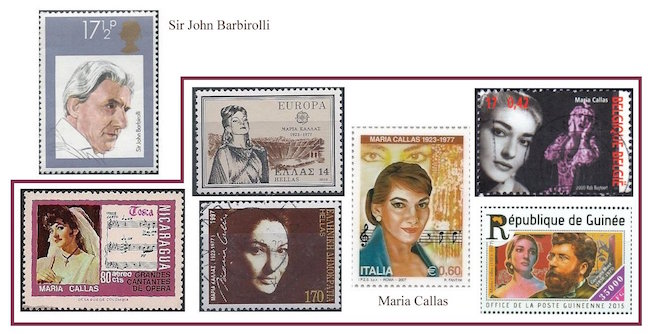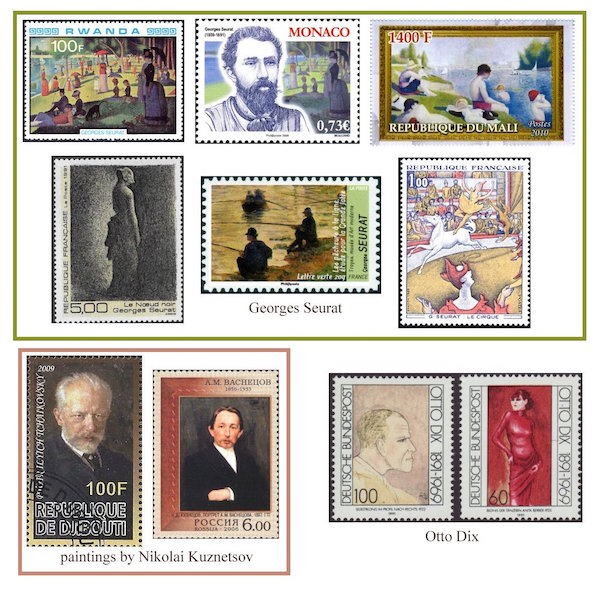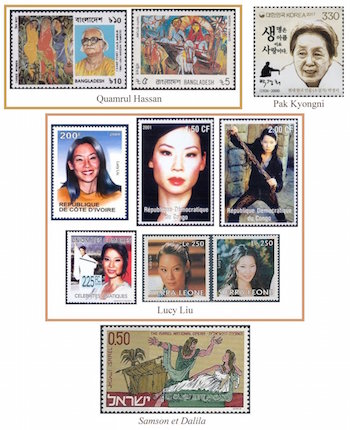The Arts on Stamps of the World — December 2
An Arts Fuse regular feature: the arts on stamps of the world.

By Doug Briscoe
Two of the greatest performing artists in 20th century music, John Barbirolli and Maria Callas, share this December 2nd birthday. They worked together in a performance of Aida that’s available on the Testament label. It’s also the birthday of pointillist par excellence Georges Seurat and the anniversary of the première of the best-known opera of Saint-Saëns.
Sir John Barbirolli (2 December 1899 – 29 July 1970), was born Giovanni Battista Barbirolli in London. His father, a violinist, was Italian, his mother French. Little Giovanni started with the violin at four, but soon switched to cello. As the story goes, he used to wander around the house while playing, and his grandfather bought him a small cello to keep him from “getting in everybody’s way.” He went to St. Clement Danes and earned scholarships to Trinity College of Music and the RCM. In the last year of World War I he enlisted in the army and went by “John” at that time, but on being demobilized reverted to his original name until 1922. He is most associated, I suppose, with the Hallé Orchestra, with which he made many recordings, specializing in British music, but he was also music director of the New York Philharmonic (1936-43) and chief conductor of the Houston Symphony (1961-67). His wife was the distinguished oboist Evelyn (Rothwell) Barbirolli. The stamp is one of a set of four honoring British orchestra conductors.
I suppose many people think of Maria Callas (December 2, 1923 – September 16, 1977) as having been European, but she was born in New York City. Her birth certificate gives her name as Sophia Cecelia Kalos, “Kalos”, which means “beautiful”, being her father’s shortening of his name Kalogeropoulos. It was he also who later modified “Kalos” to “Callas”, to make things easy for befuddled Anglo-Saxons. Besides appearing on a Nicaraguan issue honoring numerous opera stars, Callas was twice honored on stamps of Greece, where she received her musical education, and once on a sheet issued by Italy, where she established her career. I also found her on a Belgian issue and in the background of a stamp honoring Georges Bizet.

Our third star performer today is the great post-Impressionist painter Georges Seurat (December 1859 – 29 March 1891), whose large-scale work A Sunday Afternoon on the Island of La Grande Jatte (1884-86), instantly recognizable, appears in miniature on a stamp of Rwanda and on the only stamp saluting Seurat himself, one from Monaco. His first major work, another famous piece, was Bathers at Asnières (1883), which Seurat submitted to the Paris Salon without success. The Groupe des Artistes Indépendants showed it, but Seurat and other artists who felt that that group was not well organized set up their own organisation, the Société des Artistes Indépendants. The Wikipedia article offers this well-worded and cogent analysis of the Bathers: “Although influenced in its use of color and light tone by Impressionism, the painting with its smooth, simplified textures and carefully outlined, rather sculptural figures, shows the continuing impact of his neoclassical training.” Also, the Impressionist approach was typically impromptu, and Seurat departed from that ethic with preparatory drawings and sketches in oil. A stamp from Mali reproduces the painting. Two more works from this time are The Black Knot (1882) and Fishermen (1883), both shown on French stamps. In the next summer (1884), Seurat began Afternoon on the Grande Jatte, finishing it two years later. The most famous of its artistic offshoots is of course Stephen Sondheim’s musical Sunday in the Park with George (1984), with book by James Lapine. Seurat died in Paris at the age of 31 from an unknown illness, leaving unfinished The Circus, seen on yet another stamp from France.
We remain in the realm of painting for our next three people. First we go back nine years from Seurat’s birthday to that of Nikolai Kuznetsov (2 December 1850 – 2 March 1929), born and educated in Odessa, the son of a landowner. His gift was recognized early, and after lessons at a local school he enrolled at the Imperial Academy of Arts in Saint Petersburg, where one of his teachers was Pavel Chistyakov. Upon graduation he regularly received commissions and exhibited often, not only widely in Russia but elsewhere in Europe, in 1900 taking part in the Paris Universal Exhibition. For a time his studio at his country estate became a meeting place for artists of all kinds. He taught at the Academy from 1895 to 1897, whereupon he returned to Odessa. He painted portraits of Tchaikovsky (1893), fellow painter Apollinary Vasnetsov (1897), and the celebrated operatic bass Fyodor Chaliapin (1902). The Tchaikovsky and Vasnetsov portraits appear on stamps of Djibouti and Russia respectively, but neither stamp was issued in honor of Kuznetsov. I couldn’t find any that fills that particular bill. With the coming of the Russian Civil War, Kuznetsov and his family left the country for Yugoslavia, settling in Sarajevo. His daughter was the opera singer Maria Kuznetsova. (1880-1966).
Our next painter is the German Otto Dix (2 December 1891 – 25 July 1969), whose work, reminiscent of that of his friend George Grosz, was in part a candid reaction to the violence he witnessed while serving in World War I. He was born near Gera. (Coincidentally, just the other day we saw a stamp depicting Gera’s town hall, which had been designed in the 16th century by Nikolaus Gromann.) As a youngster he spent much time in the studio of his painter cousin Fritz Amann, whom he wished to emulate. Dix pursued this course with study in Dresden. When the war broke out he was at first enthusiastic and volunteered, but as the years wore on and he served on both the Western and Eastern fronts, he grew thoroughly disillusioned. As a reaction to the German Expressionist movement, Dix co-founded the Dresden Secession group in 1919 and joined the Berlin Secession in 1924. (That year saw the publication of his collection of fifty brutally honest war etchings called Der Krieg.) He met Grosz in 1920 and began experimenting with collage. A furore erupted in 1925 when his violent and unsparing painting The Trench was bought by a museum in Cologne, and the mayor, who happened to be Konrad Adenauer, not only negated the purchase but also compelled the museum curator to resign. In the same year Dix’s work was shown at the Neue Sachlichkeit (New Objectivity) show in Mannheim. He became one of the movement’s principal artists. Characteristic works of this period include the triptych Metropolis (1928), an indictment of post-war indulgence in the face of defeat (note the double amputee) and financial collapse, and the decidedly uncomplimentary Portrait of the Journalist Sylvia von Harden (1926). Naturally the Nazis loathed this sort of thing, and Dix, fired from his teaching position at the Dresden Academy, was labeled “entartete“, his work included in the notorious 1937 Munich exhibit and burned. He was even arrested for supposedly being implicated in the 1939 Elser bomb plot against Hitler, though he was subsequently released. During the Second War he was conscripted into the Volkssturm and captured by the French. Again Dix was moved to put the people’s suffering into his art. He lived in Dresden for most of the remainder of his life. For his centenary in 1991 a museum was opened in his childhood home in Gera, and Germany issued a pair of stamps, one showing his Self-Portrait in Profile Looking Right and the other his Portrait of the Dancer Anita Berber (1925).

Our fourth consecutive painter today is also the first of our three consecutive Asian artists. Bengali artist Quamrul Hassan (1921–1988) was also keenly conscious of his social milieu and was an activist in his life as well as in his art. Hassan was born in Kolkata and was so determined to follow his muse that his father, strongly opposed to a career in art for his son, nevertheless enrolled him in an art institute in 1938, as long as Hassan paid his own tuition. He became so politically involved and active in social work that it took him nine years to finish the six-year course. (He was also a devoted bodybuilder, not an avocation one commonly associates with painters.) His canvases reflect the world of folk art with a modern slant, sometimes adopting Cubism. He worked in a wide variety of media, and two of his creations, a poster and a sketch, have achieved historic status in Bangladesh. The poster, which Hassan himself circulated on March 23, 1971, is a nasty caricature of the ruthless Pakistani president Yahya Khan, who, within days, would order a military pacification of Bangladesh. (Here’s the English version.) The sketch, which I can’t find reproduced online, was directed against the dictator Hossain Mohammad Ershad and bore the title “Desh aaj bisshobeheyar khoppre” (“Our land is now in the hand of the champion of shamelessness”). Sounds like something we could use on a T-shirt right about now. The Bangladeshi stamps show Hassan himself with his Three Women (1983), the rights of women being another of Hassan’s central concerns, and The Happy Return (can’t determine a date for this). I link also to a lovely gouache, Uki.
The work of South Korean novelist Pak Kyongni (December 2, 1926 – May 5, 2008) has also strongly reflected a struggle, not so much in politics as in life itself. Her troubles began shortly after birth when her father left the family. Just a few years after her marriage she lost her husband and her 3-year-old child. Later still her son-in-law was arrested on charges of being a communist (just as her husband had been), and she had to take care of her grandson. The need for money, and a recommendation from the novelist and poet Kim Tong-ni (whose birthday is on the 13th inst.), led Pak to take up her pen. She wrote her first novel in 1955, saying at the time, “If I had been happy, I would have not begun writing.” Her most celebrated work is a massive sixteen-volume saga called Toji (The Land), which follows hundreds of characters through the historic weave of 19th- and 20th-century Korea. I gather it has been adapted into a movie, a television series, and an opera (or musical?), but my efforts to ascertain the composer of the last have been fruitless.
Actress Lucy Liu (born December 2, 1968) is Asian by ethnicity, not by nationality, as she was born in Queens to parents from Beijing and Shanghai. She spoke only Mandarin until she was five. Liu achieved fame on television’s Ally McBeal (1998-2002) and went on to further successes in the theatrical films Charlie’s Angels (2000, see the Congolese stamps) and Kill Bill (2003, see the stamp from the Comoros) as well as by playing the female Watson on the modern Sherlock Holmes series Elementary. In addition to her work as an actress, she has since her teens been creating art in painting, mixed media, and photography, and has had a number of gallery shows. From 2004 to 2006 she even returned to school for further art studies. In 2011 Liu branched out into film directing with Meena, a reality-based story of child prostitution in India. Just yesterday we offered a stamp from Côte d’Ivoire celebrating the birthday of Woody Allen, and another stamp from that same series pays tribute to Lucy Liu. There’s also a pair of stamps from Sierra Leone.

The best-loved opera of Camille Saint-Saëns, Samson et Dalila, had its first performance in Weimar (in German translation) on December 2nd, 1877. The production had been undertaken at Liszt’s urging and was conducted by Eduard Lassen. The opera was chosen for the design of a 1971 stamp to commemorate the Israel National Opera, founded in 1947, which folded in 1982.
Three of the finest writers around happen to share this December 2nd birthday, T. Coraghessan Boyle (born 1948), George Saunders (1958), and Ann Patchett (1963). And while we’re on the subject of literary matters, you may find it of interest to note that on this day in 1867 Charles Dickens gave his first public reading in the United States…at Tremont Temple in Boston.
A graduate of the University of Massachusetts with a B.A. in English, Doug Briscoe worked in Boston classical music radio, at WCRB, WGBH, and WBUR, for about 25 years, beginning in 1977. He has the curious distinction of having succeeded Robert J. Lurtsema twice, first as host of WGBH’s weekday morning classical music program in 1993, then as host of the weekend program when Robert J.’s health failed in 2000. Doug also wrote liner notes for several of the late Gunther Schuller’s GM Recordings releases as well as program notes for the Boston Classical Orchestra. For the past few years he’s been posting a Facebook “blog” of classical music on stamps of the world, which has now been expanded to encompass all the arts for The Arts Fuse.
